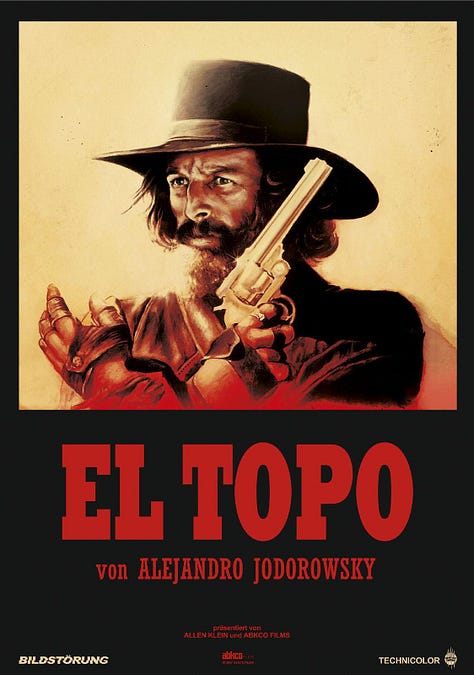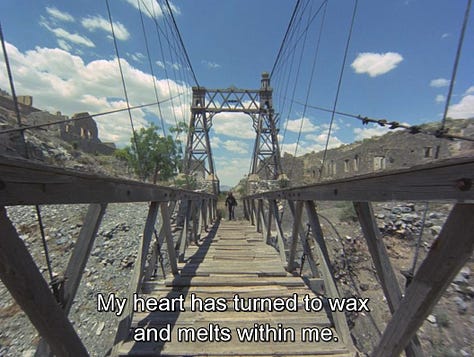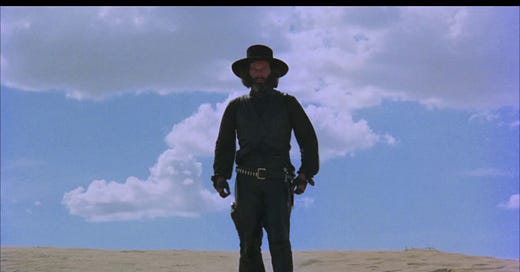EL TOPO
1970 • Alejandro JodorowskyScreenplay: Alejandro Jodorowsky
Cast: Alejandro Jodorowsky, Brontis Jodorowsky, Mara Lorenzio, David Silva, Paula Romo, Jacqueline Luis
Cinematography: Raphael Corkidi
Music: Alejandro Jodorowsky
ABKCO Films
You are seven years old. You are a man. Bury your first toy and your mother's picture.
In the tumultuous world of cinema, there are few films that can lay claim to the title of 'cult classic' with as much conviction as Alejandro Jodorowsky's 1970 mind-bender, El Topo. This movie is a trip. An acid trip. Or at least, that’s what people who have taken acid tell me, anyway. If you’re unfamiliar with the works of Alejandro Jodorowsky, then you are in for a… treat? Maybe. Depending on your view surrealist art. A film that defies traditional categorization and pushes the boundaries of storytelling, El Topo remains an enigmatic, polarizing, and undeniably fascinating work of art. It's a violent, brutal, confusing, and allegorical film all rolled into one, demanding viewers to either embrace its surreal genius or dismiss it as pretentious obscurity.
In the late 1960s and early 1970s, the counterculture movement was in full swing, with filmmakers seeking to break free from the conventions of Hollywood. If you were to boil it down to one genre, El Topo is a Western. However, it is unlike any Western you have ever seen before. Jodorowsky introduced the world to the "acid western," a subgenre that melded the traditional Western with surrealism, mysticism, and hallucinatory visuals. Jodorowsky himself plays the title character (translated to English: The Mole), a black-clad gunfighter in the mythical Old West as he travels the landscape, challenging other master warriors, stopping bandits, and avenging the slaughtered. As he fights his way through his challengers, he contemplates his own mortality and his personal demons.
The film is basically split into two parts. The first half feels like a surreal spaghetti western. Sort of Sergio Leone meets Federico Fellini. The second half is much more contemplative and focused on religious symbolism and Eastern mysticism. Jodorowsky's use of Christian and Eastern religious iconography creates a visual tapestry that is honestly bewildering. Jodorowsky himself calls the film an “Eastern” not a Western. The film delves into redemption, enlightenment, and the search for meaning in a chaotic world. It challenges conventional religious and societal norms, often through shocking and provocative imagery. As you embark on the journey that is El Topo, be prepared to enter a world where the rules of reality are fluid, and logic takes a backseat. As the narrative unfolds, you'll encounter surreal landscapes, grotesque characters, and a series of events that defy explanation.
I will spoil some of the film here, as honestly, it will help you understand the film if you’ve never seen it before. If you don’t wish to be spoiled, you’ve been warned. The film begins as a gun-slinging, leather-clad cowboy, El Topo, sets out on a quest to defeat four master gunfighters. El Topo travels with his young son, simply known as “Hijo” (“son” in Spanish). After hunting down a warlord known as The Colonel, El Topo leaves his son in the care of monks. He rides off with (abducts?) a woman named Mara, whom the Colonel kept as a slave, and she tells him that if he defeats the four greatest gunmen in the West, he will earn her love. Each gunman represents a different religion and El Topo manages to defeat them all. After defeating the gunmen, Mara betrays El Topo by shooting him in the hands and he is carried off by a band of mutant dwarves. The remainder of the film features El Topo as a religious savior to the group of mutants, of which he has promised to help them escape persecution from a town of cultists, by digging a tunnel through a cave to their freedom. Hijo arrives in the town, now a grown man and wearing his father’s black gunfighter clothes, and upon discovering his father, he intends to kill him. The film then ends in an extremely violent and bloody massacre.
The film is relentlessly brutal and purposefully shocking. Jodorowsky claimed at one point that the rape scene in which El Topo rapes Mara Lorenzio was real. He later claimed in 2009 that this was a publicity stunt intended to shock audiences. Honestly, I can believe both stories.
One of the original “Midnight Movies,” the film has become a cult classic since its original release. The film ran for 5 years as a Midnight Movie, and eventually caught the attention of John Lennon and Yoko Ono, who bought the film for distribution. Audiences were drawn to its visually stunning, mentally stimulating indulgence in gratuitous sex and exaggerated violence. The film was a countercultural icon, emblematic of an era when cinema was challenging conventions and pushing boundaries.
One of the most significant debates surrounding El Topo is its level of comprehensibility. It’s a violent, bloody, sexual, and allegorical film, yes. But what the allegory is is open to interpretation. There is a messy combination of symbolism from Christianity and Zen Buddhism. Is it about death? Or rebirth? Is El Topo Jesus? Or is he the Anti-Christ? Is it a work of genius that only the director himself truly understands, or is it a pretentious exercise in cinematic abstraction? The answer may lie somewhere in between. Jodorowsky intentionally blurs the line between reality and symbolism, leaving the viewer to grapple with their own interpretations.
Too much perfection is a mistake.









Notable Accomplishments
Avoriaz Fantastic Film Festival: Special Jury Award
Avoriaz Fantastic Film Festival: Grand Prize Nominee
Ariel Award (Mexico) Winner: Silver Ariel - Best Cinematography (Mejor Fotografía)
Streaming: Not currently streaming
Digital Rental/Purchase: Pantaflix, AppleTV, Amazon, Alamo Draughthouse
Physical Media: Available on Blu-Ray and DVD



